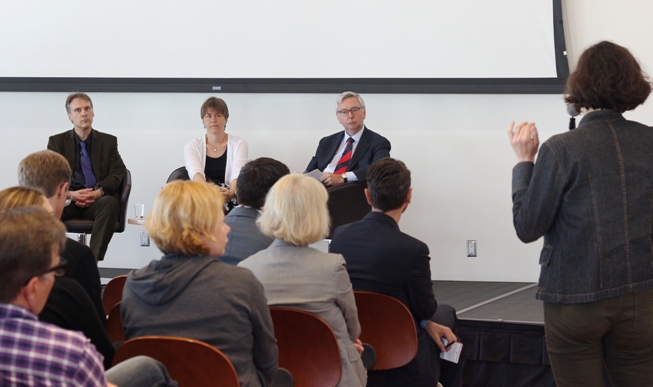Immigration and multiculturalism are important aspects of North American society. Hundreds of thousands of immigrants are welcomed by Canada and the United States every year. This Big Thinking panel at Congress 2015 examined integration policies as well as the rights and challenges of immigrants in North America and Europe, in an attempt to understand how immigration policies on these two continents differ.
Irene Bloemraad, Chair of Canadian Studies at UC Berkeley and Scholar with the Canadian Institute for Advanced Research, began by highlighting the historical consonance between immigration in North America and Europe. In the case of the US and Europe, immigration was largely restricted in the 1920s and only reopened on a large scale in 1960s. While Canadian immigration started immediately after World War II, it primarily drew people from European nations until the 1960s when immigrants of more diverse backgrounds began to arrive in Canada.
In her research, Bloemraad takes a close look at the “symbolic politics” of integration in Canada to understand whether these have an actual impact on immigrants or just amount to empty words. According to a case study from Saskatchewan in the 1980s, people didn’t want immigration from non-European countries as they didn’t want “radical transformation of ethnic make-up”. Today, by contrast, Canada’s centre-right government is a strong advocate of immigration and multiculturalism. Such discourses of inclusion, Bloemraad has found, do matter for political inclusion.
Looking at other markers of integration can also advance our study of multiculturalism. In North America, there is a birthright system of citizenship, meaning that someone born on North American soil has the right to citizenship, political participation and integration. European countries do not provide the same rights to people born there.
Thomas Faist, Professor of sociology at University of Bielefeld, Germany, identified three aspects of integration: cultural, political and economic integration. On the cultural level, the corporatist nature of religious organizations in Europe creates a hurdle for new religious communities seeking integration. Once in the system, however, religious organizations enjoy many privileges, occupying positions similar to those of unions and employer associations.
At the political level, Faist dispelled the myth that far-right governments are more restrictive to integration. This is not borne out by statistical evidence from the 1990s and 2000s. In fact, some right-wing governments have liberalized immigration laws.
In terms of socio-economic integration, Faist pointed out that it is not only a matter of immigration policy, but a question of the host nation’s economic model. Historically, therefore, immigrants to the US have been at greater risk of income poverty, whereas immigrants to European welfare states have mostly had to contend with unemployment. Today, North America and Europe are converging on the point of admitting immigrants on a human capital basis.
Many interesting questions were raised from the floor, ranging from the recent surge of immigration to Europe from African and Middle Eastern countries, to recent controversial laws in Canada that allow revocation of Canadian citizenship. The session also explored the difficulties faced by highly-skilled immigrants in Canada, namely doctors and professionals holding PhDs from South Asia, who have had difficulty finding decent work, leading some to work lower-paying jobs.
If Canada’s government does not take into account this type of discrimination and racism in the workforce, it is possible that many immigrants will look elsewhere for future opportunities, resulting in a lost opportunity for the Canadian economy, and indeed for multiculturalism itself.
Photo credits: Meagan Bell

